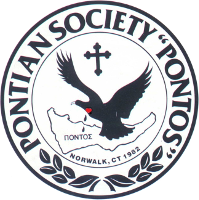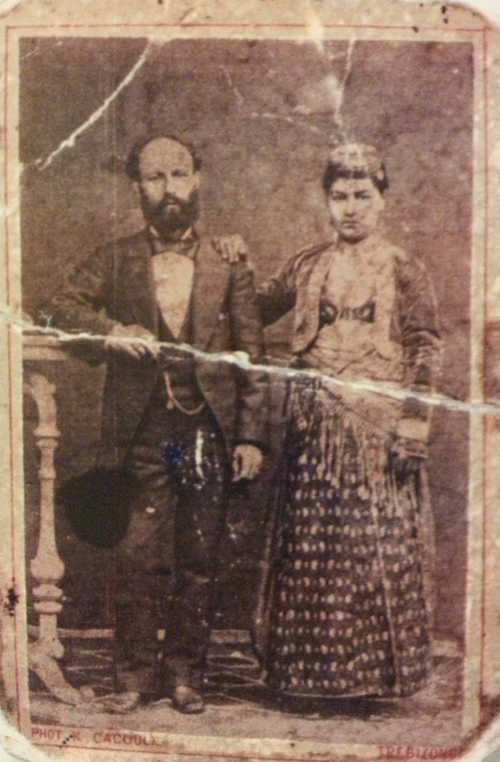Perhaps it is commonplace to say that the history of a people is the history of its language or, conversely, that the history of the language of a people is the history of that people. A confirmation that is confirmed in the case of the Pontic dialect. Thus we can see in the Pontic dialect the origins of the first Greek settlers from Ionia, the contacts of the Greek settlers with the foreign-speaking peoples they met in the area, the influences from Alexandria and R Byzantine character given to the dialect by the Byzantine way of life, (perhaps the most serious for our days) the verbal, grammatical and syntactic effect of Turkish on the Pontic dialect which is due to the long Turkish domination, and finally the lexical loans from various languages with which came into contact with the Pontic dialect such as those of the Caucasus, Russia, etc.
Watch the relevant video for the Greek Dialect in Pontus
The story begins in the 8th century BC. with the conquest of Sinope on the beach of ancient Paphlagonia by the Ionians of Miletus. Following this example, the colonists founded new colonies further east, such as those of Kotyora, Trabzon, and Kerasounta, at the same time that Miletus was creating another colony, Amisos. Greece also participated in the colonization, which in some cases created colonization elsewhere, and sent additional settlers elsewhere. Pausanias mentions the participation of the Greeks in the colonization of Trebizond in the middle of the 4th century when it had changed its name from Ozinis to Trebizonds. We have similar cases for other cities such as Amisos, which kept its Semitic name until the 6th century BC. Later in the years of their great prosperity the Athenians sent settlers and renamed it Piraeus. A name that did not prevail much after the Peloponnesian War when Amisos was separated from the Athenian alliance. Other Athenian colonies were the city of Athens in the town of Kochla, Tripoli a building of Messinian Tripoli, and Oinoi a building of the Oinoe of Attica. Hellenism from the coasts began to spread in the Mediterranean from the years of Alexander the Great, when they destroyed or Hellenized foreign nations such as Driles-Mossynoikos-Tivarinos-Halyves etc. Later, during the Roman era, new crowded cities were established both on the beach and inland, or hitherto insignificant settlements were strengthened. Such are Amaseia, Amastri, Nikopoli, Farnakia, Neokaisaria, Komana, Kavira. We are at the beginning of the 4th century, a time of the greatest prosperity and prosperity in the region, the result of deep peace in the place during the times of Roman rule.
Pontus until the time of the Byzantine Empire did not have a single political system with an administrative center. It operated according to the ancient Greek model of City-State with democratic administration. This system was overthrown by Constantine the Great, who established in the Pontus simple sovereignty of the State under a unified stato-political administration with Neocaesarea as its capital and later Trabzon under Justinian. Later, during the division of the Byzantine state into issues, Pontus numbered three (3), the issue of Chaldea based in Trabzon, the issue of Cologne based in Nikopolis, and the Armenian issue with cities of Amasia, Amisos, Neocaesarea, Sinope, etc. a. By concession and due to its strategic importance and geographical location, the issue of Chaldea enjoyed autonomy.
 In 1204 Pontus seceded from Byzantium, and was a separate state from a member of the dynasty, Alexios Komnenos. The state of Komnenos was maintained for over two and a half centuries when on August 15, 1461 it fell into the hands of Muhammad b. The state of Komnenos promoted the intellectual movement and helped the scholars of Constantinople who found refuge in Trabzon after 1204. Folk poetry, far superior to other types of artistic speech, was cultivated long before the 12th century and must definitely be found in Pontus. place the first samples of the epic of Digenes Akritas, and the songs of the Akritic cycle. After the domination of the Turks, the Christian population of Pontus is declining for various reasons. Many migrated to the coasts of southern Russia, and others to the Aegean islands
In 1204 Pontus seceded from Byzantium, and was a separate state from a member of the dynasty, Alexios Komnenos. The state of Komnenos was maintained for over two and a half centuries when on August 15, 1461 it fell into the hands of Muhammad b. The state of Komnenos promoted the intellectual movement and helped the scholars of Constantinople who found refuge in Trabzon after 1204. Folk poetry, far superior to other types of artistic speech, was cultivated long before the 12th century and must definitely be found in Pontus. place the first samples of the epic of Digenes Akritas, and the songs of the Akritic cycle. After the domination of the Turks, the Christian population of Pontus is declining for various reasons. Many migrated to the coasts of southern Russia, and others to the Aegean islands
By order of Muhammad II, many Trebizonds relocated to Istanbul. The forced Islamization of the population, as well as the mass exodus of entire areas such as Ofi and Tongia (ancient Thoania). Many of the Christians with Carthaginian martyrdom kept their religion especially in areas where there were monasteries. The churches were turned into mosques and the conqueror did not show mercy to the special religious feeling of the Greeks of Pontus. On the contrary, in the monasteries there was special treatment, with the granting of many privileges by the sultans. Famous monasteries of Pontus were:
Of Agios Ioannis Vazelon (Zavoulon) in Matsouka, the oldest monastery of Pontus founded in 270 AD.
Of Panagia Soumela (on Mount Mela, hence the name from the place name)
with foundation around 386 AD. which was the most favored monastery of Pontus.
Of Agios Georgios Peristereotas (or Peristera) with foundation in 752. In the province of Chaldia, of Agios Georgios Halinaras, of Panagia Goumera.
And more important than Agios Georgios Houtouras founded by Alexios Komninos in the 14th century.
A unique and special case in the history of religions are the so-called hidden, or threaded, or turned, that is, Christians from return, who pretended to be converted to Islam, when in fact they remained Christians. Minimal religious freedom was recognized by the Turkish government in 1856 with Hati Humayun, which aimed mainly at revealing the threads and the re-disappearance of the Christian element in the region.  One of the many tricks used by the Turks to complete the elimination of the Greek element from Pontus.
One of the many tricks used by the Turks to complete the elimination of the Greek element from Pontus.
Most of all the Greeks of the point enjoyed the quietness of the inhabitants of the mining areas and especially of Chaldia with Argyroupoli (Gumushane) as its center. In the 17th and 18th centuries the richest and most populous province of Asia Minor was Chaldia with Argyroupoli as its capital, the largest city in Pontus with over 30,000 inhabitants in its heyday. When Chaldea can no longer feed this large population, migration begins both inside and outside the borders of the point to areas such as Kerasounta, Kotyora, Amisos, but also to Bulgaria Maden, Berekettli Maden, Ak Dag and Derek Madden, et al.
The favor to the metallurgists ceased in the 19th century when they began to emigrate again to find resources to live. This expatriation during the Russo-Turkish war took on greater proportions.
 The inhabitants of Chaldia, fearing the retaliation of the Turks after the invasion of Argyroupoli by the Russians, migrated to the Caucasus and formed Greek communities. This migration became more general in 1878 when Russia annexed the Kars region from Turkey. At that time many villages of Chaldia migrated to the region of Kars.
The inhabitants of Chaldia, fearing the retaliation of the Turks after the invasion of Argyroupoli by the Russians, migrated to the Caucasus and formed Greek communities. This migration became more general in 1878 when Russia annexed the Kars region from Turkey. At that time many villages of Chaldia migrated to the region of Kars.
From the middle of the 19th century and after the publication of Hati Humayun, the Greeks developed activity and again occupy the first place in the economic life of the country. Trabzon again became the center of transit trade from the interior of the country to Mesopotamia, and Persia.
Amisos (Samsun), a purely Turkish city (in the middle of the 19th century Greek was Ano Amisos, inhabited by those who had moved from old Amisos), where a Greek settlement was founded again, with settlers from Cappadocia, Istanbul and elsewhere, who grew and progressed very quickly.
Kerasounta, a coastal town with commercial activity, port of the province of Cologne. Kotyora as well, which served the hinterland on a limited scale. Cappadocia, as is well known outside Amisos, had sent settlers to both the city and the region of Pafra. It is the time when an educational renaissance is taking place in Pontos. The Trebizond Tutoring Center has been an educational center since the 17th century, similar to which the Tutoring Center of Argyroupoli was founded in the province of Chaldia in the 19th century. The progress of the Greeks in letters and in economic life, in combination with the increase of the population, always caused fear among the Turks. However, it did not take long for the life of the Greek Pontians to change radically after the overthrow of the sultanate, when in 1908 the party of the union and progress of the Neo-Turks came to power. The program was proclaimed by the party, or by all means and means, by the non-religious inhabitants of the Ottoman state. After the Balkan war, and its amputation by the Ottoman state, in 1914 the Greeks were declared persecuted in the Turkish state. During the outbreak of World War I and under the pretext of beach security, they implemented a large-scale deportation program, which included massacres, bodily harm, rape, starvation and extermination, extermination marches, forced labor in the labor battalions. tambourine), exiles, and the like honoring the neighboring country in the course of history. All this practice wiped out half the Greek population from the territory of the Neo-Turkish state and in fact in terms of age, the youngest population.
From 1914 to 1923, there are an estimated 450,000 Greeks in Pontus, who were exterminated by the most inhumane means. With the Treaty of Lausanne, the agricultural population settled in the northern provinces of the state, while the urban population in the cities, such as Athens, Piraeus, Thessaloniki, Kavala, Drama, etc. With this installation in Greece, the history of the Hellenic Pontus that lasted 2,700 years is dramatically completed.
SOURCE: kotsari.com

